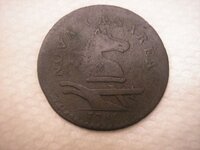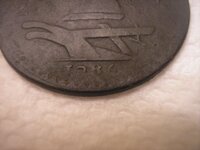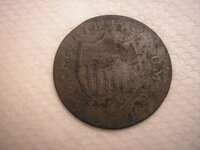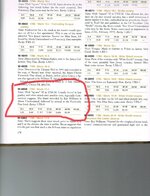Silver Tree Chaser
Bronze Member
Greetings - My first post!
I'm looking for some helpful advice on this 1786 New Jersey copper that I found back in May. It had been sitting in mineral oil for the past three months until last night when I closely examined the coin's surface. The obverse side with the horse head is in wonderful shape for being found in Southern New England; soil here is tough on copper coins. Plowed fields are brutal on copper coins, but I dug this Jersey Copper from a tavern site in the woods. The coins reverse has bonded with some dirt and likely has relatively mild corrosion. I only lightly brushed the coin's back side and some dirt came off with little or no loss of detail.
What should I do? Try cleaning it further or leave it alone? What do you think? Please reply - that way, if it comes out awful, I'll have others to blame along with me (just joking).
Seriously, I know that if I clean it further, I may loose some detail. If it goes really bad, I could loose some patina and surfacing. Use a oiled tooth pick, pencil eraser, tooth brush? I've read all about the warnings in regards to cleaning coins, and I'm somewhat skeptical. I'll take a well-done cleaned coins over an untreated ugly coin without eye appeal. Eye appeal is very important in a nice, old coin.
I want to make the right move on this find. It's a fairly valuable and rare variety of a 1786 New Jerser Coppper. Colonial and Early American Coins by Bowers list this coin as a Maris 17-J Variety with a rarity scale of URS-8 - estimated at 65 to 124 known specimens. He values this variety as follows: Fine - $1000, Very Fine - $3000, E.Fine - $5000. The attached scan for the coin's pricing is possibly to small-sorry!




Thanks for looking and any input that can be provided.
Good Hunting,
The Silver Tree Chaser
I'm looking for some helpful advice on this 1786 New Jersey copper that I found back in May. It had been sitting in mineral oil for the past three months until last night when I closely examined the coin's surface. The obverse side with the horse head is in wonderful shape for being found in Southern New England; soil here is tough on copper coins. Plowed fields are brutal on copper coins, but I dug this Jersey Copper from a tavern site in the woods. The coins reverse has bonded with some dirt and likely has relatively mild corrosion. I only lightly brushed the coin's back side and some dirt came off with little or no loss of detail.
What should I do? Try cleaning it further or leave it alone? What do you think? Please reply - that way, if it comes out awful, I'll have others to blame along with me (just joking).
Seriously, I know that if I clean it further, I may loose some detail. If it goes really bad, I could loose some patina and surfacing. Use a oiled tooth pick, pencil eraser, tooth brush? I've read all about the warnings in regards to cleaning coins, and I'm somewhat skeptical. I'll take a well-done cleaned coins over an untreated ugly coin without eye appeal. Eye appeal is very important in a nice, old coin.
I want to make the right move on this find. It's a fairly valuable and rare variety of a 1786 New Jerser Coppper. Colonial and Early American Coins by Bowers list this coin as a Maris 17-J Variety with a rarity scale of URS-8 - estimated at 65 to 124 known specimens. He values this variety as follows: Fine - $1000, Very Fine - $3000, E.Fine - $5000. The attached scan for the coin's pricing is possibly to small-sorry!




Thanks for looking and any input that can be provided.
Good Hunting,
The Silver Tree Chaser




